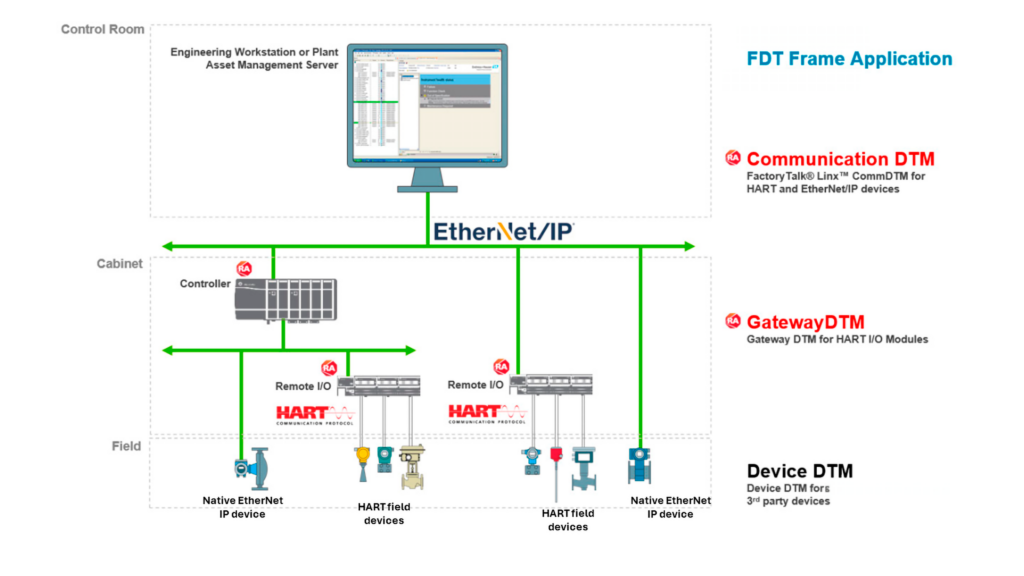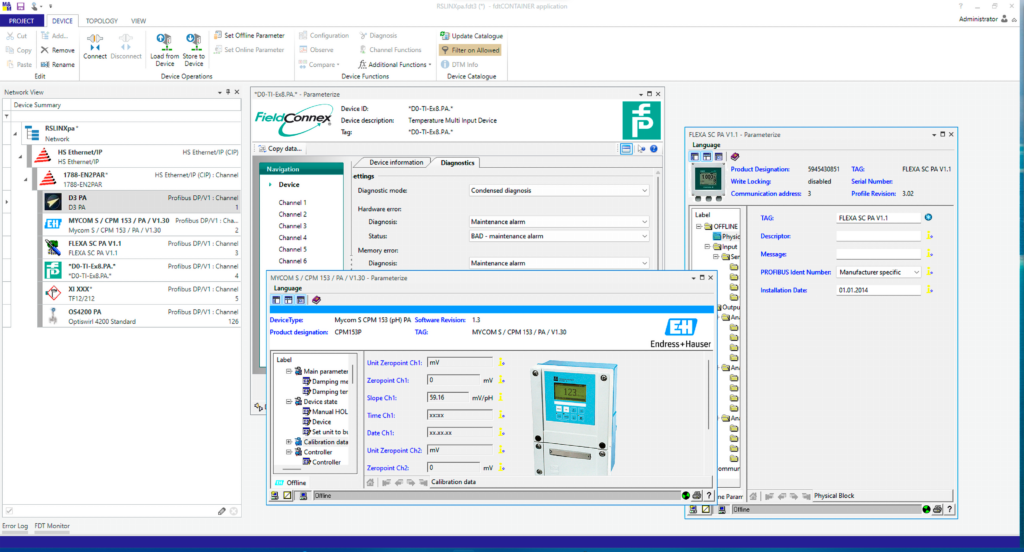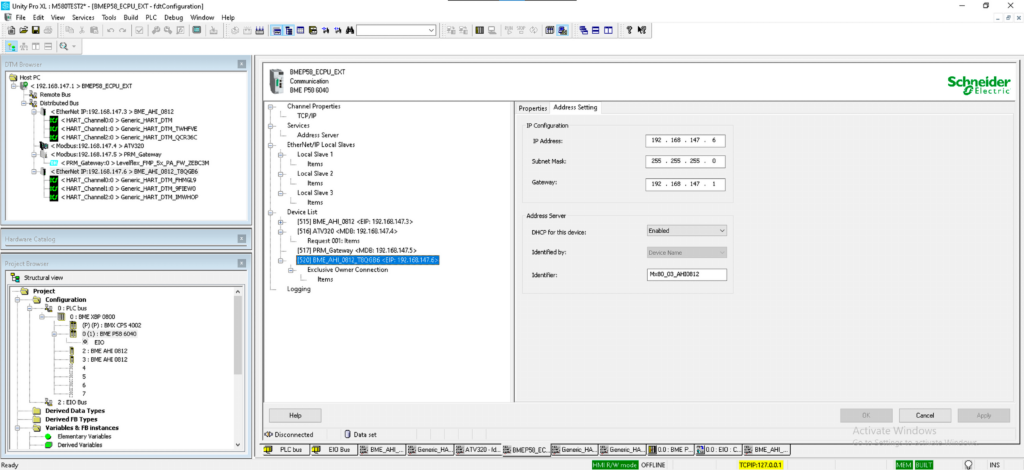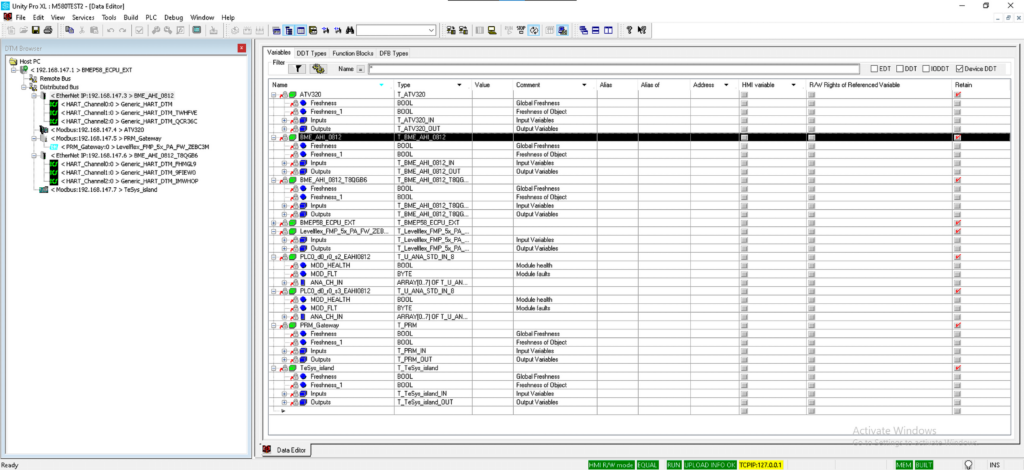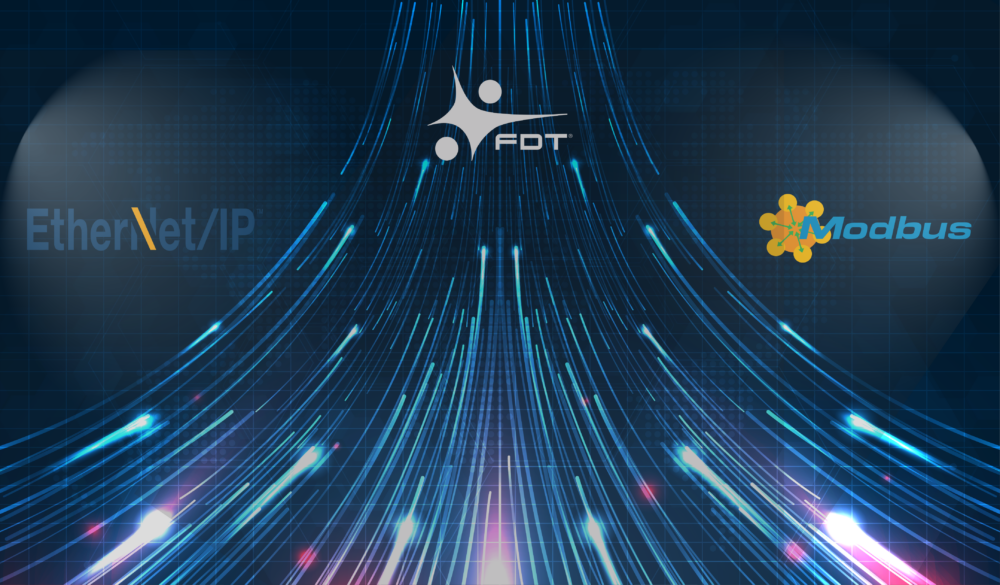
Two different worlds
There is a great divide between each continent’s preferences in almost every imaginable liking between North América and Europe. Fast food vs slow food, Starbucks vs little coffee dwellings, huge SUVs vs small compact cars, interstate highways vs narrow one lane streets, ODVA vs PI (Profibus and Profinet International).
These Standard Development Organizations have a large market share in their respective regions of influence. The ODVA managed protocols have an overwhelming share in the North American automation market. That situation is reversed in Europe, where the PI managed protocols enjoy market dominance.
Since ODVA’s introduction in 1995, the Standards Development Organization that manages the CIP (Common Industrial Protocol) has been improving the capabilities of the CIP media-independent network protocol and its four adaptations to different physical layers.
In the past, industrial network protocols used to be designed for specific applications, like those related to control tasks, information management and safety. The result of this approach was that at any plant, multiple network protocols were used, all of them working in different physical layers. Today, these multi-protocol applications are experiencing incompatibility challenges that result in information silos where data exchange between environments is only possible by closed/proprietary solutions.
The road to Open Standards
Due to the universal adoption of Internet-based technologies, the need for network compatibility is driving the development of solutions based on Open Standards, most frequently focused on the seven layers of the OSI communication model. However, even by working in this way, seamless integration between systems cannot be guaranteed.
ODVA developed four different network standards, EtherNet/IP, DeviceNet, ControlNet, and CompoNet, all of them based on the same communication protocol.
The CIP protocol includes an extensive suite of messages and services for the broadest industrial automation applications — control, safety, energy, synchronization & motion, information, and network management. CIP allows users to integrate these applications with enterprise-level Ethernet networks and the Internet, offering them an integrated approach to achieving enterprise-wide IT/OT integration.
EtherNet/IP
Currently, the most popular implementation of the CIP protocol is EtherNet/IP, which enables the use of standard Ethernet technology in industrial automation applications and additionally provides users with the tools necessary to implement industrial level requirements like real-time support, motion control and media redundancy.
With the increasing requirement of solutions for use in hybrid plants applications, or plants that feature a mix of process- and factory-oriented automation applications, there is a growing need for methods to integrate smart field devices into EtherNet/IP networks.
In the past, the usual way of achieving these goals would have been based on some proprietary hardware for protocol translation, adding unnecessary complexity and additional points of possible failure to an already complex installation.
The role of FDT technology in an EtherNet/IP environment
For over 20 years, FDT/DTM (IEC 62453) has become the de facto device integration and management standard by defining the interfaces needed at the host, communication, and device levels allowing a universal end-to-end approach for data exchange and lifecycle management supporting processes, hybrid, and discrete markets. The standard brings openness and simplicity to heterogenous protocol and device environments via a unified environment delivering modern asset health monitoring to the user community.
The FDT/DTM concept uses a framework container software application that can be implemented in a stand-alone configuration application, embedded into engineering solutions like DCS or PLCs, along with asset management applications. The FDT framework hosts software drivers called Device Type Managers (DTMs) that run and give transparent access to all data, diagnostics, and features from all connected intelligent field devices through any protocol/network due to the technology’s agnostic networking integration strength.
This article will primarily focus on integrating the EtherNet/IP network in an FDT hosting environment and the value of a special DTM called a Communication DTM (CommDTM) that manages protocol-related operations.
Different DTM types for different tasks enable flexibility
DTMs are the key software component enabling a unified control system environment opening the door to flexibility and scalability for manufacturing applications in process, hybrid, discrete and motion control applications. There are several types of DTMs:
Device Specific DTMs: These DTMs are supplied by the manufacturer of your devices and provide users with the widest range of access to the device’s set of parameters and customized features. There are third party developers that can customize DTMs with extended configuration options or advanced diagnostics.
Interpreter DTM: These DTMs are not created for a specific device. Interpreter DTMs offer a translation service for other types of device description files, such as Device Descriptions (DDs), Electronic Device Descriptions (EDDs), Field Device Integration (FDI) Device Packages, IO Device Descriptions (IODDs), Electronic Data Sheet (EDS) files, etc. These DTMs are usually packaged with the delivery of system vendor’s FDT-enabled engineering application, transparently converting any device driver type to configurable objects, therefore enabling the use of devices without native FDT/DTM support.
Generic/Universal DTMs: Generic DTMs are created with the purpose of providing bidirectional access to the device parameters that are compliant with a specific protocol profile. For example, there are many Generic HART DTMs which provide access to the set of parameters defined under the “Universal and Common Practice Commands” section of the HART protocol standard. A Generic DTM can be created to support any protocol to seamlessly integrate and manage devices in a unified environment.
Communication DTMs (CommDTMs): CommDTMs create a communication channel that works performing the communication operations of the mapped network protocol. CommDTMs function as the standardized device driver for either a single protocol or multiple protocols. The CommDTM is the first DTM needed for the integration of a field device in an FDT implementation.
Gateway DTMs: These DTMs allow transparent communications between different communication protocols in an FDT/DTM-based system architecture. Gateway DTMs work like a link between the CommDTM and the Device DTMs. They allow bidirectional communications across the system.
Two different approaches
The strength of FDT technology resided in its open and agnostic approach allowing any vendor, protocol, or device to plug and play. This strength is the key to limitless control system flexibility and adaptability offering a complete interoperable environment for intelligent device management, enterprise wide.
The below examples explain how two companies heavily involved in both ODVA and FDT Group followed different paths in their way to use FDT technology highlighting its flexibility strength promoting open but customized solutions.
Rockwell Automation approach to FDT Technology
Rockwell Automation’s FDT technology adoption approach is focused on the integration of HART enabled field devices. Taking advantage of the “nested communications” feature of FDT technology, which allows the transference of data between tunneled protocols. This is accomplished using Gateway DTMs that support every HART enabled I/O card model that the company produces.
The “nested communications” feature offers transparent access to the HART field devices connected to the HART enabled I/O cards which work as HART to EtherNet/IP Gateways.
To maintain consistency with the configuration of legacy devices, Rockwell prefers to use alternative integration mechanisms for non-process applications.
To connect these Gateway DTMs to the EtherNet/IP network, Rockwell supplies the FactoryTalk Linx CommDTM. This DTM manages all the communication related tasks between the HART field devices and the plant’s asset management system.
The FactoryTalk CommDTM is capable of use with any FDT hosting application for asset health monitoring. It has been evaluated with all the leading FDT Framework applications available, such as Endress + Hauser’s FieldCare or PACTware Consortium’s PACTware.
The general architecture of a Rockwell Automation EtherNet/IP FDT application follows the graphic below:
Application examples:
Rockwell’s goal for using FDT technology is to provide a direct access path to intelligent field devices, enabling asset management tasks from any PC or Client with an FDT Framework application installed and connected to the plant’s EtherNet/IP network.
The Rockwell Automation solution for the integration of smart field devices is based on the FactoryTalk Linx CommDTM. This DTM allows communication between the computer where the FDT Framework application is installed with all the HART Gateways available in Rockwell’s product portfolio.
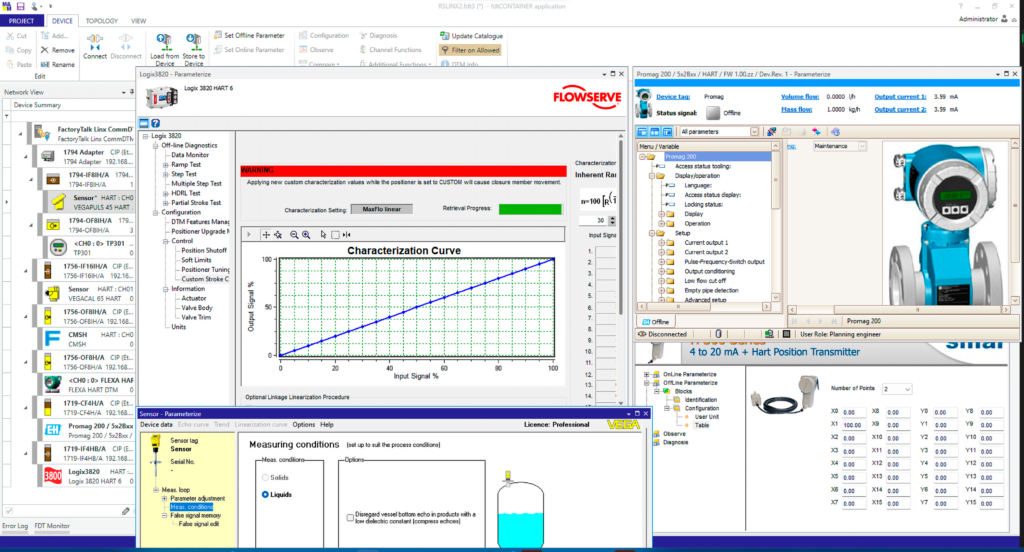
fdtCONTANER (FDT framework) by M&M Software hosts the FactoryTalk Comm DTM allowing the integration of HART devices into Rockwell EtherNet/IP plant installations.
This CommDTM supports the Rockwell Automation series of I/O cards: 1756, 1718, 1719, and 1794. The supported I/O cards include the HART Channel for FLEX5000 HART-enabled I/O modules and the AADvance Controller HART-enabled I/O cards.
The FactoryTalk Linx CommDTM also provides Rockwell’s Controllers with access to field devices with native EtherNet/IP support and with an available DTM.
Mainly due to Ethernet’s historical shortcomings in field applications, there are few devices available on the market that support EtherNet/IP connectivity, and the ones that exist are usually complex and expensive ones such as Coriolis and magnetic flow transmitters. Drives with DTM support are available from Schneider Electric.
There is even an EtherNet/IP to Profibus PA Linking Device made by the company Aparian Inc., which has a DTM that allows the integration of Profibus PA devices into an EtherNet/IP network. A Foundation fieldbus to EtherNet/IP version is also available.
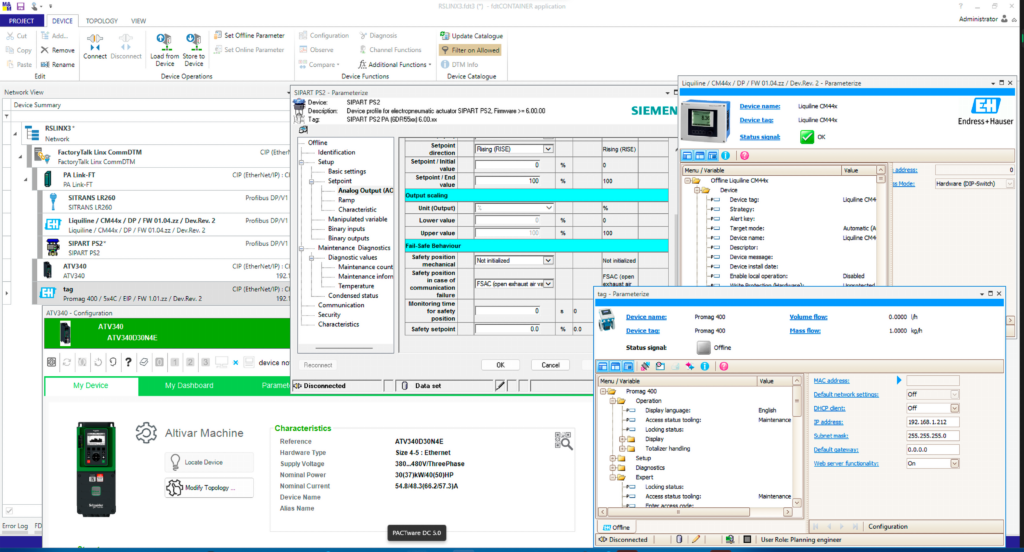
The PA Link DTM from Aparian offers Profibus PA support for EtherNet/IP systems, making Profibus PA devices accessible like native EtherNet/IP devices, such as the ATV340 motor controller from Schneider Electric or the Promag400 flowmeter from Endress+Hauser
Additionally, there is a legacy CommDTM called the RSLinx Flex Rail Communication DTM. It integrated the FLEX Rail HART enabled I/O modules of the 1794 (standard IO modules) series and the 1797 (intrinsically safe IO modules) series. Although this hardware family is no longer available, many Brownfield installations still use them.
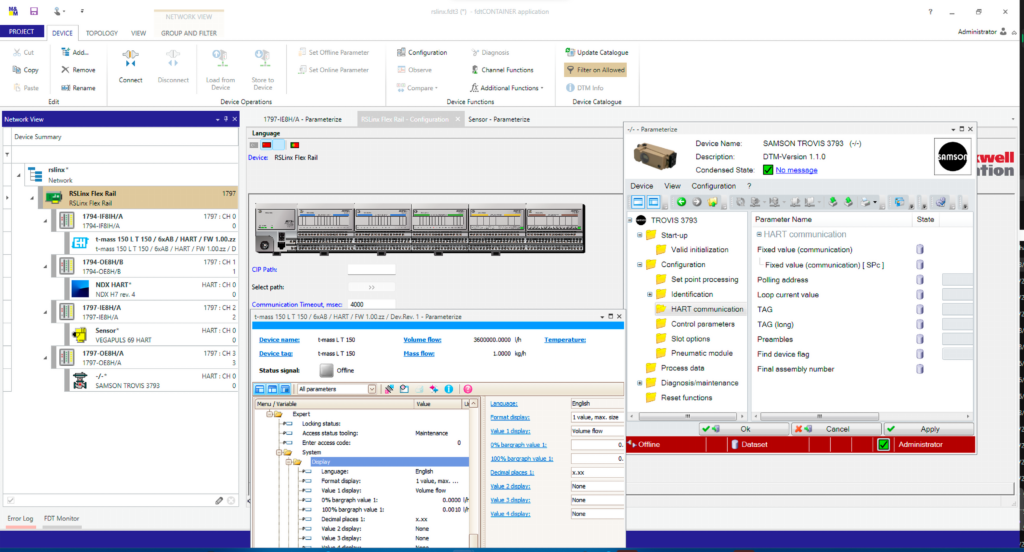
Application example of the RSLinx Comm DTM, the DTM Interfaces shown correspond to the E+H t-mass flowmeter and to the Samson Throbis 1 valve positioner, the Comm DTM appears behind
The possibility of using an FDT-based Framework application to perform asset management of HART field devices connected through FLEX Rail modules can extend the lifecycle of an old installation.
Comparing the 1794 and 1797 DTMs, the latter shows a rich menu for HART related, offline parameterization options.
Finally, through the acquisition of the South African company Hiprom in the early 2000’s, Rockwell acquired the ability to connect both Foundation Fieldbus and Profibus PA segments to their EtherNet/IP enabled controllers using an EtherNet/IP-enabled DTM-based Linking Device.
This solution has also been retired but is an interesting example of the flexibility offered by FDT technology. The integration of Profibus PA and FF networks is done by using Aparian’s linking devices.
Schneider Electric’s approach to FDT Technology
Schneider Electric adopted a different way to use FDT technology in their offerings.
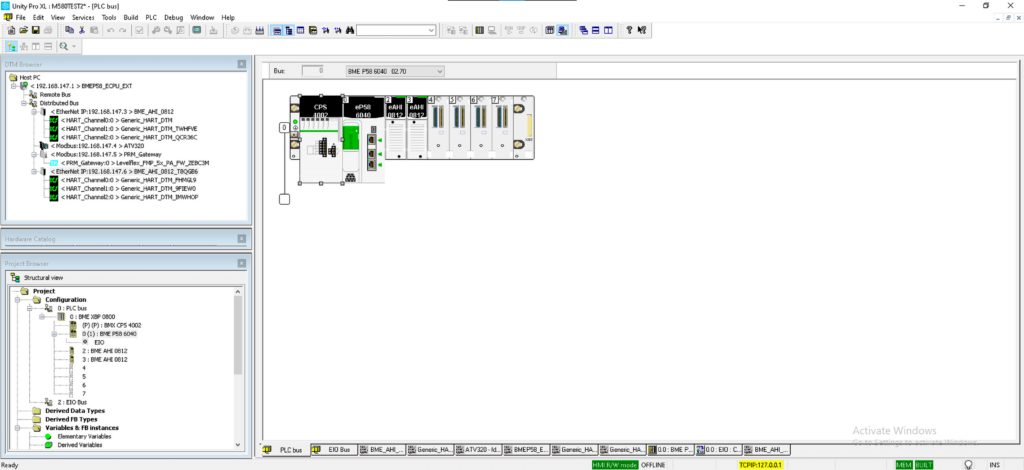
A M580 Schneider Electric PLC, with the corresponding backplane, power supply and two HART enabled 8 channels AI modules, viewed through the embedded FDT Framework of the EcoStruxure Control Expert software tool.
Schneider Electric embedded an FDT framework container across their entire family of configuration and engineering tools. The FDT framework is embedded into the EcoStruxture Control Expert engineering tool, as well as into the Ecostruxture Machine Expert tool optimized for applications like motion control, mechatronic/robotics, smart MCCs and drives configuration, simulation, diagnostics, and network setup.
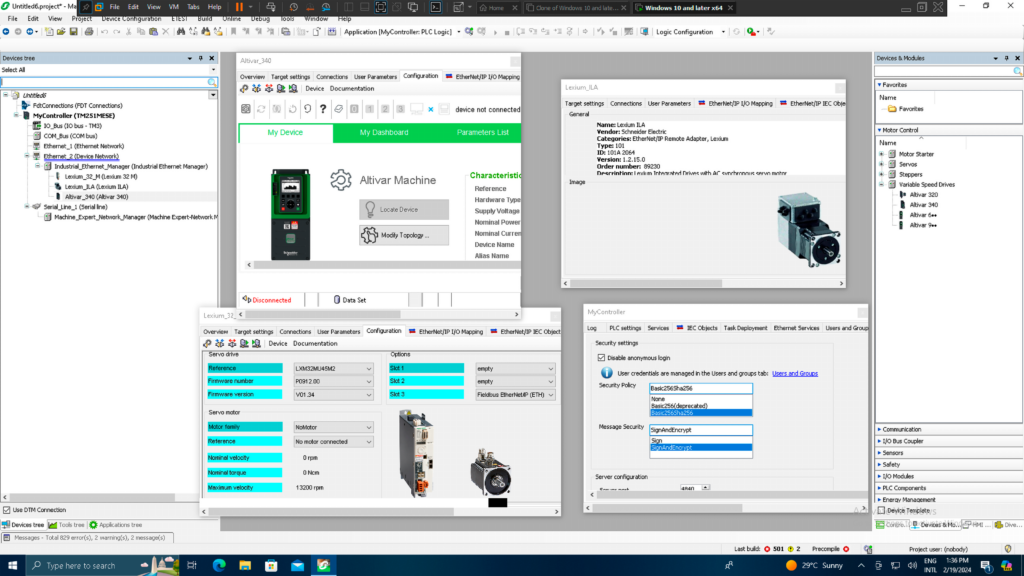
A screenshot of the EcoStruxure Machine Expert software showing the DTMs of a Lexium drive, an Altivar VFD, and a Lexium IA Stepper motor for motion control and a TM 251 CPU
The company also has a FDT based software solution called SoMove. This is a user-friendly setup software for PC, designed to simplify and accelerate the configuration of Schneider Electric motor control devices.
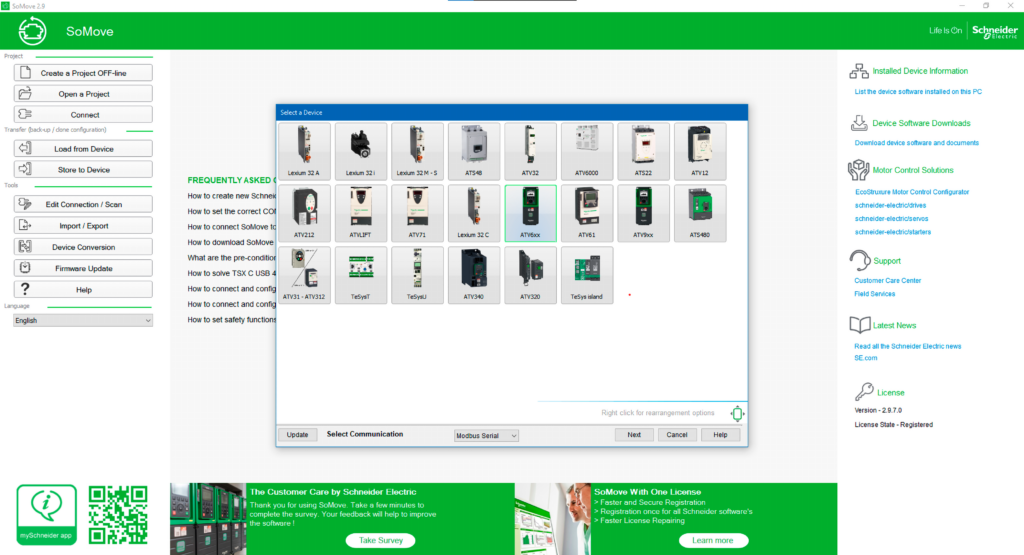
The SoMove FDT based stand alone application allows users to perform the configuration, parameterization, monitoring and diagnostics of Schneider Electric’s motor control devices.
This approach allows Schneider Electric to use one DTM for the integration of a device in multiple software applications, with the additional benefit of maintaining the same user interfaces in all the applications.
These two application examples demonstrate how FDT technology can be used as a solution for factory automation applications and clearly demonstrate the flexibility of the FDT technology concept.
The FDT-embedded environment runs transparently behind the scenes, and many users do not realize they use the FDT/DTM concept. By following this approach, Schneider Electric can offer integration support for EtherNet/IP and Modbus TCP industrial Ethernet protocols.
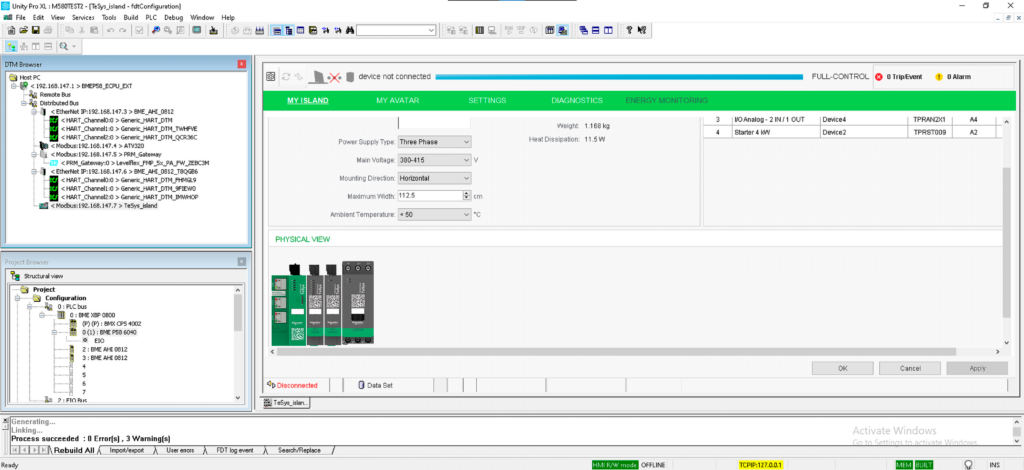
A M580 PLC equipped with 2 HART enabled AI cards trough EtherNet/IP, an Altivar motor controller, a PRM Profibus Gateway and a TeSys modular motor control system EcoStruxure Rix through Modbus TCP
Since Schneider Electric has a wide range of Modbus TCP-enabled MCC (Motor Control Center) hardware, they can offer variable frequency drives and motor starters that can be configured and integrated using corresponding Device DTMs.
This option is also available for EtherNet/IP hardware, if they have an available DTM file. If that is not the case, then the corresponding EDS file must be imported into the DTM catalog.
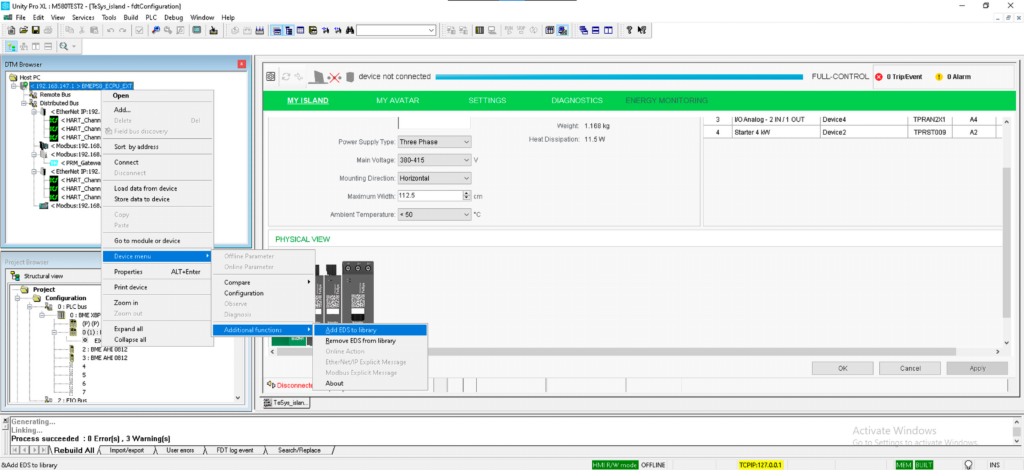
Importing an EDS device descriptor into the DTM catalogue. This is done through the CPU’s DTM which works like an Interpreter DTM.
Schneider Electric’s Ecostruxure platform uses FDT technology at the core of its solution. In this way, the Controller’s hardware configuration uses DTMs. Each module connected to the PLC’s rack is configured through the DTM Browser tool.
So, in this case, using a standalone FDT Framework application is unnecessary because the PLC engineering tool itself is a native FDT hosting application.
Compared with the typical method of using a separate (standalone) FDT framework, the benefits of this approach are that mismatches or errors between the FDT/DTM configuration and the PLC’s hardware configuration are eliminated because they are the same thing.
One consequence of this approach is that the hardware requirements of the Asset Management workstation are higher than those of the typical FDT Framework PC. However, the benefits of a unified and methodically coherent user interface for all the hardware integration tasks performed in a controller’s hardware configuration tool are notable.
The use of an FDT-based engineering tool also provides Schneider Electric with support for both EtherNet/IP and Modbus TCP Generic DTM generators and interpreters.
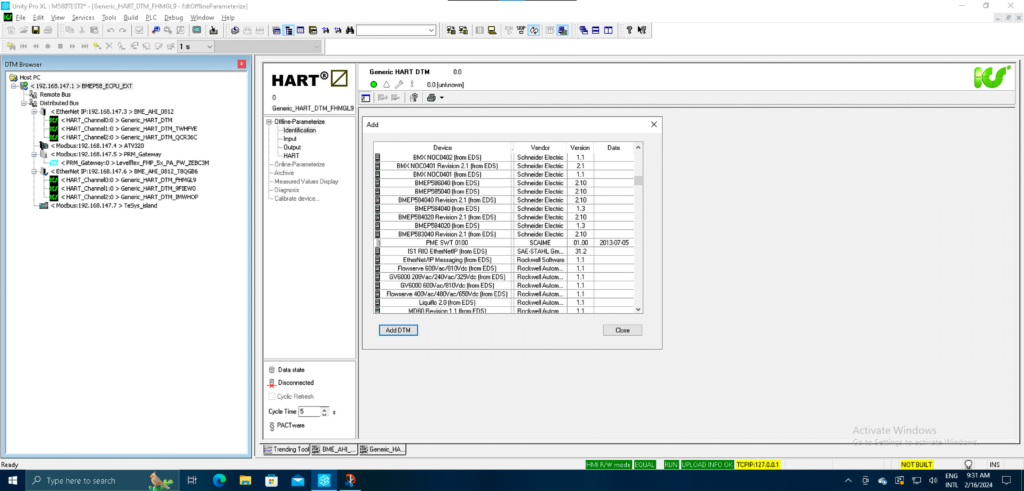
The embedded DTM catalogue, showing a variety of DTMs generated from imported EDS device descriptions from devices supported by Schneider Electric and Rockwell.
Schneider Electric offers Generic DTMs for EtherNet/IP modular and non-modular devices and has included a built-in function in their FDT framework that uses an Interpreter DTM to automatically generate DTMs based on the Ethernet EDS description files used by EtherNet/IP devices. A Modbus TCP DDXML Generic DTM is also available to integrate Modbus TCP hardware that uses DDXML files as device descriptors.
So, the approach employed by Schneider Electric is to support the integration of Modbus TCP, EtherNet/IP, HART, and Profibus hardware using Device DTMs or, if they are not available, support for these devices use Generic DTMs created using the embedded Interpreter DTM.
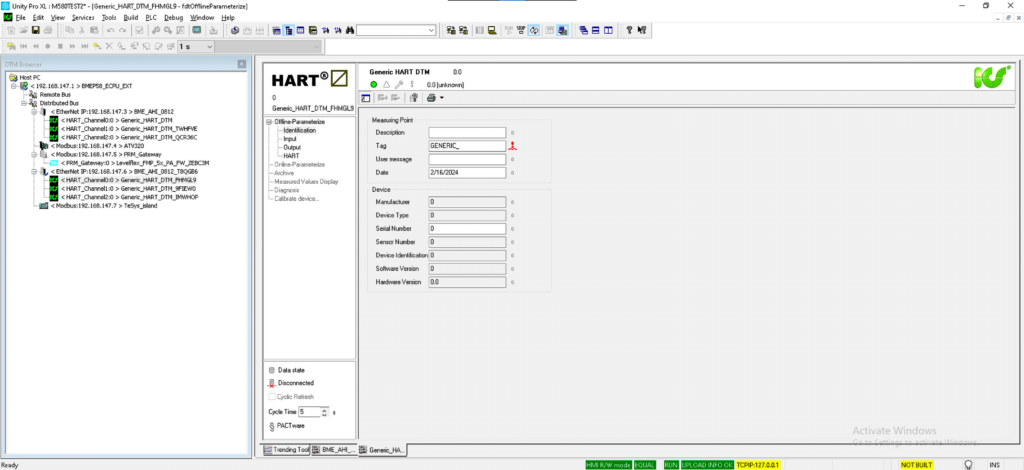
HART field devices connected to 2 EtherNet/IP enabled HART AI I/O cards. HART data is transparently available to the system.
One advantage that the engineering tool with an embedded FDT framework has when compared with a standalone framework is that the engineering tool needs to verify the PLC’s hardware’s configuration integrity after each configuration change. It will not accept non-compatible DTM combinations, while a standalone FDT tool may be more prone to these issues. The fact is that a faulty hardware configuration may render the PLC unusable until the problem is solved, but a standalone framework is independent of the PLC’s configuration.
One limitation of this approach is that HART enabled I/O cards integrated through their EDS files will not be capable of transferring HART information. That means that nested DTM communications is not supported by Interpreter DTMs. However, this is rectified if a combination of native device DTMs, Comm DTMs and Gateway DTM are deployed in the topology.
This approach makes the extensive portfolio of EtherNet/IP devices available in the market compatible with Schneider Electric’s controllers. And by using the Interpreter DTM concept, it is not necessary to demand individual Device Specific DTMs from the suppliers.
Simplified Lifecycle Management via a Unified Environment
These two examples show how flexible FDT technology is while simplifying the integration using a mixed networking topology to access smart devices within a unified environment for lifecycle management. Whether supported natively through an engineering tool with an embedded framework or a standalone framework application, the availability of a single, easy-to-use, familiar interface for hardware integration, with the communication protocol’s independence, greatly benefits the end users.
Finally, the use of FDT technology enables control systems to gain full access to the rich datasets available on state-of-the-art smart devices, opening the doors to advanced applications such as the NOA concept, IT/OT integration, and the connection of the control system to the Internet of Things (IIoT).
In our next issue, we will examine implementation use cases and innovation using FDT technology with Profibus/Profinet based applications that take precedent across the Atlantic Ocean in the European market.
